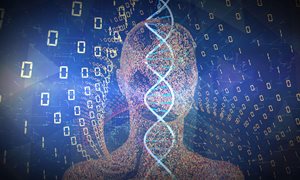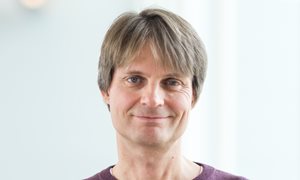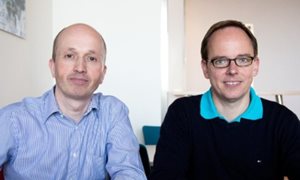 My name is Huib Croes, Dutch and I am working as a technician at the Microscopic Imaging Centre (MIC).
My name is Huib Croes, Dutch and I am working as a technician at the Microscopic Imaging Centre (MIC).
When you were a kid what did you want to be when you grew up? Can you tell us something about your child years.
As a child I didn’t concern myself much with the future or what I would like to become when I grow up. You see, we lived at the edge of a village and thus I loved spending my time, besides playing sports, with roaming through meadows and forests.
What was your previous academic training, where did you study and why that study?
During my military service I worked at the Clinical Chemistry Laboratory in the Military Hospital, because of this experience I decided to pursuit an education to become a technician at the OLAN in Nijmegen.
The RIMLS motto is: ‘Today’s molecules for tomorrow’s medicine’. What does this mean for you?
The introduction of GFP and GFP likes as tracking reporters has accelerated bioimaging, resulting in the need for highly specialized microscopes.
Before ‘Today’s molecules’ can be applied in ‘Man’ one must first examine its expression and/or interaction in vitro and in vivo using one of these sophisticated microscopes and that is where we (MIC) come in.
Who is your great example as scientists? And please give a motivation why.
I don’t really have one particular scientist who I see as a “role model“ or who I admire. I do, however, greatly admire the scientists who, through their enthusiasm, knowledge and determination, are able to motivate others to go the extra mile and invest surplus hours in order to elevate themselves and who sometimes order a pizza when overtime lurks around the corner.
Which research discovery that you have made has made you most proud?
The result that is most notable for me is the discovery that, by using immune electron microscopy, the crystalline inclusions in mitochondria of mitochondrial myopathies consist of mitochondrial creatine kinase. A fun anecdote is that we made this discovery just before Christmas. We therefore decided to put a photo of these gold-labelled crystalline structures as a Christmas card on the desk of the head of the department. At first, he couldn’t believe his eyes and thought we fooled him so he tried to remove the small black dots, which looked like as if they were made with a marker.
Given unlimited finance what experiment would you perform?
If I was given unlimited funding, I would consider to continue the mesothelial cell research. This is, in my opinion, still an undervalued cell that deserves more attention. Especially because it is a multi-potent cell.
What does your working area (desk, office) look like and what does it say about you (or your research)?
I like to see my desk as a piece of organized chaos. And thus I regularly point others, who observe my desk, to Albert Einstein’s photo hanging above my desk with the saying:
“If a cluttered desk is a sign of a cluttered mind, of what, then, is an empty desk a sign? – Albert Einstein
Nominate a colleague to be in the spotlight and what would you like to ask him or her?
I would like to nominate Ben Joosten of the department of Cell Biology-Nanomedicine and I would like to ask him “Can you tell the story behind your tattoos?”.
What type of person are you, quick insights:
a) Mac or PC? : PCb) Theater or cinema? : Theater
c) Dine out or dine in? : Both
d) Ferrari or Fiat? : E-bike
e) Shopaholic or chocoholic? : Definitely not a shopaholic
f) Culture or Nature : Both
Related news items

Nijmegen literally puts Digital Health on the map Flourishing ecosystem gets its own interactive overview
22 July 2021 Digital Health is thriving in the Nijmegen region, where it contributes to better care and health and also creates jobs. To bring developers and end users even closer together, The Economic Board and the Radboudumc are introducing the Interactive Digital Health map. go to page
First online FIJI course
12 June 2020 Although Jack Fransen, Marieke Willemse and Merijn van Erp missed the personal classroom interactions, they can again look back to a successful course thanks to an enthusiastic group of 14 students who helped them through this first online version. go to page
NWO open call GROOT grant for Peter Friedl
24 February 2020 Peter Friedl, theme Cancer development and immune defense, received a 300,000 EUR grant within the NWO-GROOT consortium "Active matter of cancer metastasis" to identify the mechanisms of collective metastasis in breast cancer. go to page
Prinses Beatrix Spierfonds grant to investigate patient stratification in myotonic dystrophy
24 January 2020 RIMLS researchers Rick Wansink and Roland Brock, both theme Nanomedicine, received a € 280,000 grant from the Prinses Beatrix Spierfonds. go to page
p120-catenin-dependent collective brain infiltration by glioma cell networks
7 January 2020 Pavlo Gritsenko and Peter Friedl, theme Cancer development and immune defense, report in Nature Cell Biology, that glioma cells infiltrate the brain by a collective network mechanism, which critically depends on p120 catenin. p120 thus represents a potential target to combat glioma. go to page
